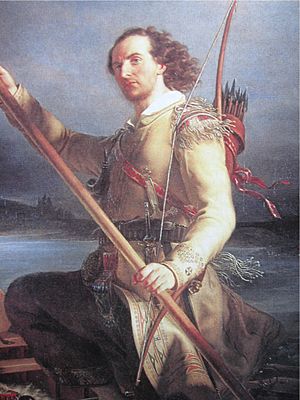Giacomo Beltrami facts for kids
Giacomo Costantino Beltrami (born 1779 – died January 6, 1855) was an Italian judge, writer, and explorer. He is famous for saying he found the very start of the Mississippi River in 1823. This happened during a trip across the United States. Later explorers found a different source for the river. In Minnesota, a town called Beltrami and a large area called Beltrami County are named after him. He knew many important people, including members of the powerful Medici family.
Early Life and Travels
Giacomo Beltrami was born in Bergamo, a city in northern Italy. He was the 16th of 17 children! We don't know his exact birthday because a fire destroyed birth records in 1793. He went to school and studied literature and law.
In 1797, he became a soldier for the Cisalpine Republic. This republic was connected to France and the government of Napoleon. Beltrami became a Mason and worked for Napoleon's government. Later, when the Marche region was controlled by the papal government, he was questioned about his past activities.
Beltrami married the sister of Count Pietro Bastogi, a famous Italian railway builder. In 1809, Beltrami became good friends with Giulia Spada dei Medici. When she died in 1820 at age 39, he was very sad. He gathered her writings to honor her. Her death, along with questions about his past, made him want to travel far away. He visited many cities in Europe. In 1822, he reached Liverpool, England. From there, he sailed to the United States. After two months at sea, he arrived in Philadelphia, Pennsylvania in late 1822 or early 1823.
Exploring North America
In the U.S., Beltrami visited many cities. He decided to travel down the Ohio River. His plan was to follow it to the Mississippi River and then go south to New Orleans, Louisiana. On his boat trip, he met Lawrence Taliaferro. Taliaferro was an important U.S. agent who worked with Native American tribes. He was planning to travel up the Mississippi River.
Beltrami soon became very interested in finding where the Mississippi River began. In 1823, he joined Taliaferro and Stephen H. Long. They traveled up the river to Fort Saint Anthony. Beltrami explored and mapped with Long and Taliaferro. They also met with local Native American tribes.
After about three months, in July, Beltrami started to disagree with the others. In August, when the group reached Pembina, he left their expedition. He set off with some Ojibwe guides to find the river's source on his own. After only a week and a half, his guides left him. He had to continue alone, asking for help from people he met.
During his journey, Beltrami collected two Native American flutes. He later sent them back to Italy with other Native American items. One of these flutes is the oldest Native American flute still existing today. It is now in a museum in Bergamo, Italy.
On August 28, Beltrami found what he believed was the source of the Mississippi River. He also thought he found the source of the Red River of the North. He named the place Giulia, after his friend who had passed away. He also named eight nearby lakes after her children. He then traveled back downriver to Fort Saint Anthony. From there, he continued south to New Orleans, arriving in December. In New Orleans, he started writing about his travels. His book was finished by late January and published a few months later.
By that time, Beltrami was traveling through Mexico. There, he collected Aztec objects and studied plants and animals. He also observed the political system of the area. Because of his work with plants, he became a member of several scientific groups in France. He returned to New Orleans in 1825. Soon after, he went back to Philadelphia, where many copies of his book were stored. Some religious groups did not agree with his ideas and spoke against his work. By November, he was meeting important people at parties for the opening of New York's Erie Canal.
Return to Europe
After visiting places like Haiti and Santo Domingo, Beltrami sailed back across the Atlantic Ocean in 1826. He arrived in London late that year. Two years later, he moved to Paris. He joined several scientific groups in the early 1830s.
In 1834, Beltrami moved to Heidelberg, Germany. There, he became friends with Josef Anton Mittermaier, a well-known judge. A few years later, he finally returned to his home in Filottrano, Italy. He tried to get his books published in Italy, but the government, which was led by the church, said no. In his last years, he lived like a Franciscan friar and called himself "Fra Giacomo." He spent most of his time working in his house and garden. He died there in 1855.
Images for kids



